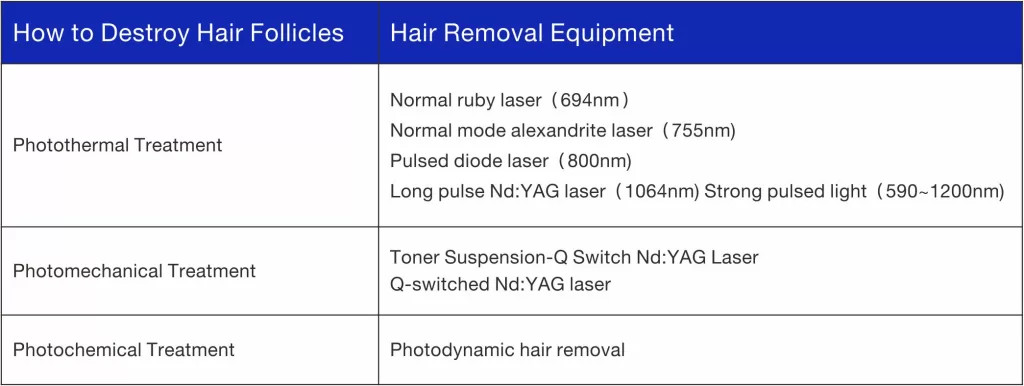How Does Laser Hair Removal Work?
Laser diode hair removal works by having the melanin in the hair follicle absorb the laser's heat, destroying the follicle. Hair growth has three stages: anagen, catagen, and resting. During the anagen phase, hair follicles produce and transport a large amount of melanin, making laser damage most effective. In the catagen and resting phases, melanin-related metabolism stops, so the laser treatment is less effective. Therefore, depending on the hair growth cycle, laser hair removal typically requires 3 to 5 or more treatments to achieve permanent results.
What Kind Of Lasers Are Widely Used for Laser Hair Removal?

How Many Laser Hair Removal Treatments Are Needed?
There are three cycles of hair growth: growth phase, resting phase, and catagen phase. Laser has a removal effect on hair that contains more melanin in the growth phase, but has a relatively weak therapeutic effect on hair in the catagen and resting phases. Hair in the same area will be in different growth cycles, and hair in different areas will have different growth cycles, so you need multiple treatments to achieve the desired effect.
The number of treatments varies for different body parts and is directly proportional to the efficacy. For example, the first laser diode hair removal session can remove about 30% of the hair. After two treatments, 40% to 50% of the hair is removed, and after three treatments, 60% to 80% of the hair is eliminated.
What Is the Interval Between Laser Diode Hair Removal?
Hair in different parts of the body has different growth cycles, and the treatment interval should vary according to different parts. If the hair's resting period in the treatment area is short, shorten the interval accordingly; conversely, extend the treatment interval.
The resting period of head and facial hair is short, so the treatment interval is 1 month. For hair on the trunk and limbs, the resting period is longer, making the appropriate interval about 2 months. As treatment progresses, hair in the growth phase shifts to the resting and catagen phases, requiring gradually extended intervals.
For example, the second treatment can be performed 6 to 8 weeks after the first treatment. The third treatment may take anywhere from 3 to 6 months. Treatment intervals should depend on the growth of new hair. If the time between treatments is too long, it will result in an increased number of treatments.
In addition, hair removal results vary by body part. The chest, armpits, and perineum respond best, usually achieving desired results after 3 to 6 treatments. Hair on the limbs, face, and neck follows. However, hair and beards respond poorly, while women's upper lip hair requires the most treatments, typically 5 to 12.
PZLASER has been deeply involved in the field of laser diode hair removal for 20 years and understands the pain points that physicians encounter during the laser hair removal process. After 3 years of research and clinical trials, we have released the latest generation of EOSICE hair removal laser machine. This cutting-edge device utilizes optical waveguide technology for energy emission, resulting in significantly enhanced hair removal efficacy for stubborn and tender facial and nasal hair. As a result, the overall treatment duration is reduced.
How Do Waveguides Enhance the Performance of Laser Hair Removal?

Firstly, waveguides in diode lasers maintain coherence and directionality, ensuring efficient delivery of laser energy to hair follicles for maximum effectiveness. Secondly, confining the laser beam within the waveguide minimizes energy loss, resulting in precise targeting and enhanced safety during hair removal treatments.
In conclusion, waveguides in diode hair removal laser play a crucial role in ensuring efficient laser energy delivery to hair follicles. By maintaining coherence and directionality, waveguides enhance treatment effectiveness. Additionally, confining the laser beam within the waveguide minimizes energy loss, resulting in precise targeting and improved safety during hair removal treatments.
What Are the Postoperative Precautions?
Under normal circumstances, there may be a mild burning sensation at the treatment area after surgery, which usually subsides in 2 to 3 hours. Some people experience partial whitening and zooming of hair, as well as slight erythema and edema around the hair follicles. This is a normal reaction after treatment and is often temporary. It usually recovers in 2 to 3 days. Use ice packs for 10 to 20 minutes to reduce erythema and edema, and keep the treated area clean.
(1) Do not use soap and hot water to clean the treatment area on treatment day.
(2) You can use cosmetics 48 hours after surgery if there are no blisters or scabs, except in cases with blisters and epidermal damage.
(3) Topical antibiotic ointment should be applied twice a day to avoid any digging and scratching.
(4) If persistent erythema (duration >1 week) or pigmentation occurs, you can take oral vitamin, and use topical L-vitamin C and 3% hydroquinone cream. The lips and exposed parts should avoid sun exposure for 1 month after laser hair removal to prevent pigmentation at the entrance of hair follicles.
(5) Avoid photosensitive foods and drugs within 4 weeks after surgery.
(6) It takes 1 to 2 weeks after laser hair removal treatment for the damaged hair shaft to be discharged and fall off. This is not a sign of new hair growth.
Conclusion
For more insights from experienced professionals, we recommend reading Dr. Kerstin Langenberger’s article on laser diode hair removal.






